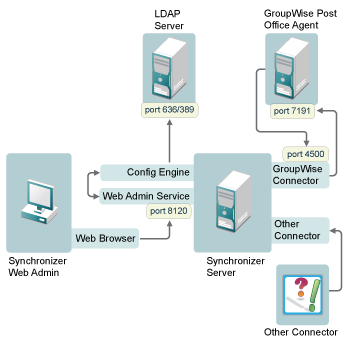2.2 Preparing to Install the Data Synchronizer Software
The Data Synchronizer Installation program cannot run successfully unless you have properly prepared the environment where you run it.
2.2.1 Preparing the Linux Server
-
For best security, select a Linux server that is inside your DMZ as the location for your Synchronizer system.
-
Make sure that the Linux server where you plan to install Data Synchronizer meets the system requirements listed in Section 1.2, Data Synchronizer System Requirements.
-
Make sure that the Synchronizer server has a static IP address.
-
Make sure that the Linux operating system media is accessible from the Synchronizer server.
The Data Synchronizer Installation program might need to install additional operating system RPMs that are required by Data Synchronizer. The Data Synchronizer Installation program can access the operating system files on a DVD or in a repository that is available from an FTP site or a Web server.
2.2.2 Preparing the Network
-
Make sure that any firewalls between the Synchronizer server and other applications have been configured to allow communication on the following ports:
Port Number
On Server
Description
636/389
LDAP
LDAP server secure or non-secure port
7191
POA
GroupWise Post Office Agent (POA) SOAP port
4500
Synchronizer
GroupWise Connector listening port for event notifications
8120
Synchronizer
Synchronizer Web Admin port

The GroupWise Connector initially communicates with the POA that you specify during Data Synchronizer installation on the SOAP port that you specify. As users synchronize with other applications, the GroupWise Connector determines from the initial POA the IP addresses and port numbers of all POAs where users have their mailboxes. Therefore, the GroupWise Connector can communicate with multiple POAs throughout your GroupWise system.
2.2.3 Disabling an Existing Web Server
If necessary, stop and disable any existing Web server that is currently running on the Synchronizer server.
For example, to stop the Apache Web server and its associated instance of Tomcat:
-
In a terminal window, become root by entering su - and the root password.
-
Enter the following commands to stop Apache and Tomcat:
/etc/init.d/tomcat5 stop /etc/init.d/apache2 stop
-
Enter the following commands to make sure that Apache and Tomcat do not start again when you reboot the Synchronizer server:
chkconfig --del apache2 chkconfig --del tomcat5
2.2.4 Verifying GroupWise System Availability
-
Make sure that the GroupWise trusted application key for the GroupWise Connector is accessible to the Data Synchronizer Installation program on the Synchronizer server.
For more information, see GroupWise Trusted Application.
-
Make sure that the GroupWise POA that the GroupWise Connector will communicate with is currently running.